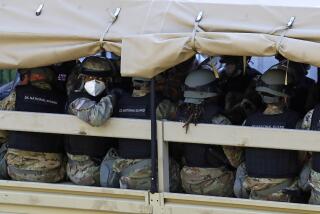Defense Could Be a Casualty in Coming War for Funding
- Share via
If a major reassessment of U.S. military policy is about to begin, can bruising interservice conflicts over roles, missions and weapons be far behind? Not likely. So as the Clinton administration prepares to launch what could be a momentous review of how the nation’s defense structure should be reorganized for the early decades of the 21st century, the uniformed services and their supporters in Congress and the defense industries can be assumed to be girding for battle. The object as always is to protect turf and even, where possible, to enlarge it.
The driving question behind the review is how big a military force the United States should have to meet the global responsibilities it has assumed. Current policy posits, unrealistically, an ability to fight two major regional conflicts--say in the Persian Gulf and on the Korean Peninsula--at virtually the same time, in the same way the United States fought on different fronts in World War II. From that goal comes the calculation of how many ground troops, tanks, bombers, fighters, transport aircraft and ships are needed, and where they should be deployed.
But if the pending review determines that the two-war strategy is unfeasible, as it surely is, then there will be powerful reasons to cut back on the 1.45 million people now in uniform. That would mean smaller defense budgets, and if experience is any teacher it would quickly mean bare-knuckled fights over who gets what. The risk, as always, is that resources won’t necessarily go where they would best meet the nation’s defense needs but instead for programs that have the greatest appeal on Capitol Hill.
A key consideration is sure to be how advanced technology can be substituted for personnel and traditional equipment. Would newer versions of the precision guided munitions we saw in the Persian Gulf War--whose accuracy, we now know, might have been considerably overstated--mean that fewer planes, bombs and missiles would have to be bought? Would comprehensive electronic monitoring of the battlefield shrink the number of tanks and infantrymen that would have to be deployed?
Arguments over these and related questions promise to be bitter and prolonged. In the past, such differences too often led to unsatisfactory compromises that seemed more designed to protect the status quo than to produce the soundest defense structure. It will take strong leadership this time around, both civilian and uniformed, to assure that service rivalries aren’t allowed to override compelling policy needs.
More to Read
Get the L.A. Times Politics newsletter
Deeply reported insights into legislation, politics and policy from Sacramento, Washington and beyond. In your inbox twice per week.
You may occasionally receive promotional content from the Los Angeles Times.










